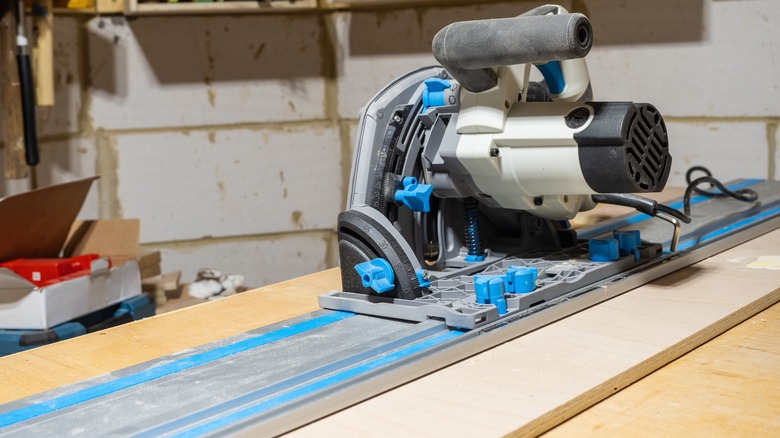How To Cut Down Large Pieces Of Wood Without A Table Saw
Any aspiring DIYer watching woodworking channels on YouTube knows two things about table saws. The first is that they're the heart of the workshop — it's a rare project that doesn't find its way across the table saw at least once. The second is that table saws are enormous platforms across which entire sheets of plywood glide effortlessly, resulting in perfect cuts. Table saws are core tools to invest in for any woodshop, but the plywood glide is a lie for most people. TikTok DIYer Crystel Montenegro knows that it's challenging or impossible to manage a heavy sheet of plywood, and especially on the small contractor-style benchtop table saws most DIYers have. In a 2022 video, she shows two better alternatives for handling large sheet goods like plywood using a ripping guide or straight edge.
A third alternative she discards would actually work in some situations. It is possible to measure and mark your cut, then follow your markings with a circular saw for a moderately accurate cut. This tends to result in rough or wavy lines that won't do for most purposes, but might occasionally suffice if the edge is being attached to something wide and will be covered with trim. But, as Montenegro notes, you can't really free-hand a cut accurate enough for demanding work like cabinet-building, and it's better to get in the habit of making these cuts correctly.
The circular saw fence attachment
Montenegro's first solution is a product called the Kreg Rip-Cut. The Rip-Cut is basically an advanced version of the circular saw fences you can buy for (and which actually come with) some saws. These must-have saw accessories simplify DIY projects by attaching to the saw and the fence runs along the edge of your workpiece, guiding the cut. Unsurprisingly, it's a sound solution for rip cuts, those long cuts along the grain. It's also especially useful for making repeated, identical cuts, as when breaking down plywood into a bunch of identical strips (for a shiplap look, for example).
The fence jig approach does have some important limitations, though. As the Kreg version's name implies, it's suitable for rip cuts, but less so for crosscutting. One reason is that they can typically only handle about 24 inches of width. So if you wanted to cut a 4x8 sheet into two 4x4 halves, you couldn't make a cut deep enough. Another is that you must have a factory edge or an otherwise well-cut, straight edge for the fence to run along that is parallel to the cut you want to make. And, finally, cuts made with these fences can get a little funky at the end of the run where the fence is mostly no longer engaged, and you end up free-handing them anyway.
Straight edges and track saws
Montenegro's other solution is a different kind of fence. While the Kreg Rip-Cut is, like a table saw fence, attached to your saw, there are advantages to attaching a fence to the wood itself as a guide for your cuts. She recommends clamping a straight edge to your plywood, paneling, etc. and running the saw against that edge for a straight cut anywhere on the wood — not just where there's a clean parallel edge. This approach is similar to the modus operandi of track saws, long guides in which specialized circular saws travel for perfect cuts. But track saws can cost hundreds of dollars (or a lot more) and can lock you into a particular saw manufacturer. Kreg has a couple of solutions for this, too: the Accu-Cut universal crosscutting jig that accepts most circular saws and can make cuts up to 48 or 100 inches long (depending on the model), and the 48-inch Straight Edge Guide, which works basically like Montenegro's clamped-down straight edge.
Her approach of using any suitable straight edge is flexible, cheap, and accurate. It is probably a good enough solution for DIYers who don't need to quickly break down entire truckloads of sheet goods. One thing to watch out for is the height of your straight edge. Using a long aluminum ruler can be troublesome if your saw's base plate has a slightly curved profile that doesn't engage perfectly with a thin ruler, causing the saw to stray a little.

